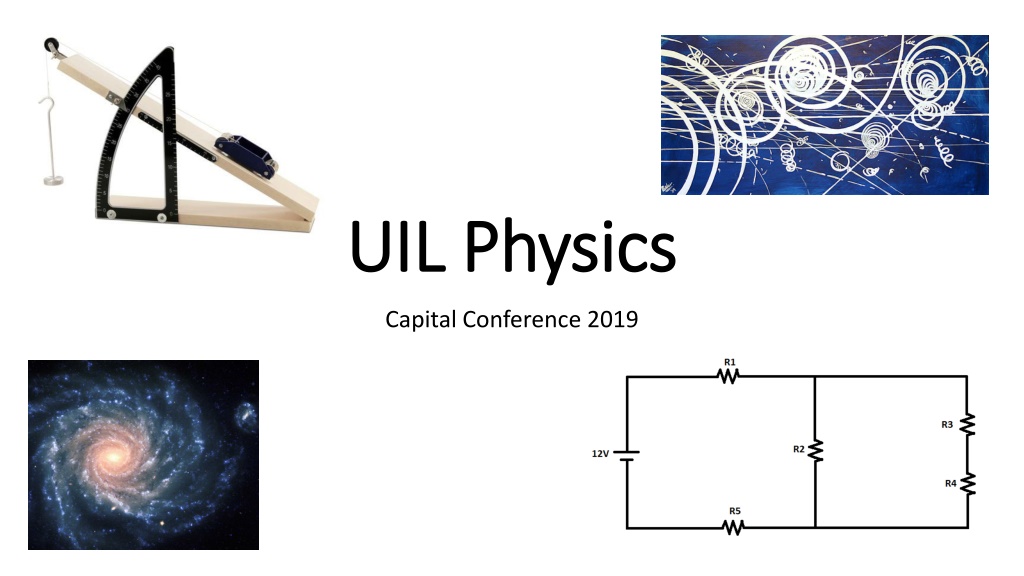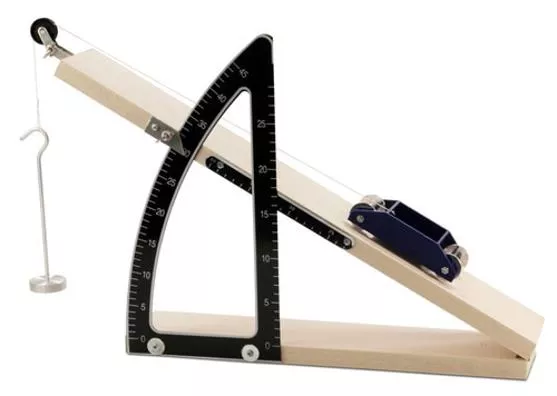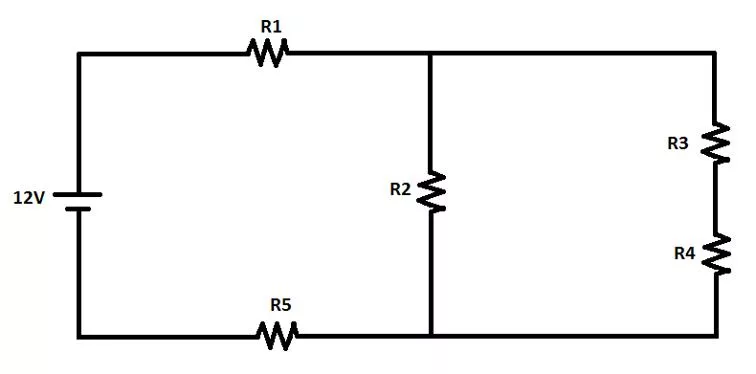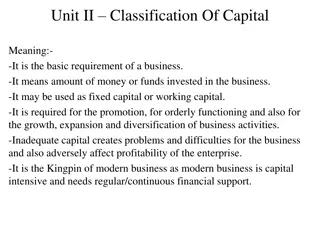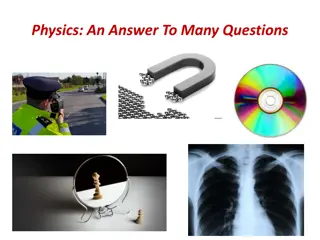UIL Physics Capital Conference 2019 Topics & Questions Overview
The UIL Physics Capital Conference 2019 featured various physics topics and questions ranging from teaching quantum physics to dogs to fields like astronomy, measurement, uniform motion, forces, energy, and more. The event covered a wide array of physics concepts, and the directed study text focused on "How to Teach Quantum Physics to Your Dog." Different levels of difficulty were assigned to test questions, and a structured process was followed to generate and finalize questions. Additionally, samples of physics questions were provided for reference.
Download Presentation

Please find below an Image/Link to download the presentation.
The content on the website is provided AS IS for your information and personal use only. It may not be sold, licensed, or shared on other websites without obtaining consent from the author. Download presentation by click this link. If you encounter any issues during the download, it is possible that the publisher has removed the file from their server.
E N D
Presentation Transcript
UIL Physics UIL Physics Capital Conference 2019
Topics by Question: Physics Questions P1 P3 will be from How to Teach Quantum Physics to Your Dog by Chad Orzel. Physics Question P4 will be from the field of Astronomy. Physics Question P5 will be about Measurement/Dimensional Analysis/Significant Figures/Order of Magnitude. Physics Question P6 will be about Uniformly Accelerated Motion. Physics Question P7 will be about Forces. Physics Question P8 will be about Work/Energy/Power/Momentum.
Topics by Question: Physics Question P9 will be about Circular and Rotational Motion/Equilibrium. Physics Question P10 will be about Waves/Sound/ Harmonic Motion. Physics Question P11 will be about Fluid Statics and Dynamics/ Thermodynamics. Physics Question P12 will be about DC Circuits/Resistors/Capacitors. Physics Question P13 will be about Electric Fields and Forces/Electric Potential/Gauss Law. Physics Question P14 will be about Magnetic Fields and Forces/Magnetic Materials/Ampere s Law.
Topics by Question: Physics Question P15 will be about Faraday s Law/Induction/EM Oscillation and Waves/AC Circuits. Physics Question P16 will be about Geometric Optics/Wave Optics. Physics Question P17 will be about Modern Physics/Quantum Physics. Physics Question P18 will be about Nuclear Physics/Particle Physics. Physics Question P19 will be a wildcard question from the topics traditionally covered in a Physics 1 course. Physics Question P20 will be a wildcard question from the topics traditionally covered in a Physics 2 course.
Physics Directed Study Text How to Teach Quantum Physics to Your Dog by Chad Orzel Directed Study Questions Invitational A chapters 1-3 Invitational B chapters 1-3 District chapters 4-5 Regional chapters 6-7 State chapters 8-10
Each Test Increases in Difficulty Each Test Increases in Difficulty for example, consider questions from P07: Forces Level 1: Invitational Level 3: Region and State Level 2: District
The Process Generate two-three potential questions Choose question number Solve, decide if difficulty is correct Topic is determined Decide form: for example P07: inclined or not static or dynamic friction? Work incorrectly, making common mistakes Finalize images constants etc
Sample Physics Questions Sample Physics Questions
Our Sun is currently fueled by which fusion reaction? A) The CNO cycle (H He) B) The Proton-Proton cycle (H He) C) Double-Alpha fusion (He Be) D) Triple-Alpha fusion (He C) E) Carbon fusion (C Na, Ne, Mg)
(B) The specific fusion reaction in the Sun is known as the proton-proton cycle, in which hydrogen nuclei (protons) are combined through a series of steps to form helium nuclei. The other hydrogen-to-helium fusion process, the CNO cycle, can only occur at the extremely high temperatures found in massive blue and white stars. Other fusion processes (those starting with helium or carbon) occur only when a star has exhausted it supply of hydrogen fuel these are end-of-life processes for a star, typically when the star is in the giant or supergiant phase.
A truck is travelling at 32.0m/s along a straight highway. It accelerates at 2.78m/s2 for 8.00sec. How far did the truck travel while it was accelerating? A) 434 m B) 345 m C) 256 m D) 167 m E) 78.1 m
(D) Since we have the time of the constant acceleration, and the initial velocity, we can use the following kinematic equation: ? = ?0+ ?0? +1 2??2= 0 + 32 8 + 0.5 2.78 82= 167m.
While cleaning the library, Belle pushes a 21.0kg box of books across a frictionless floor. She pushes with a force of 35.0N angled downward at 20.0 below the horizontal. What is the acceleration of the box of books? A) 1.77 m/s2 B) 1.67 m/s2 C) 1.57 m/s2 D) 0.639 m/s2 E) 0.570 m/s2
(C) Since the floor is frictionless, we only have three forces present: gravity (downward), the normal force (upward), and the applied force (angled at 20.0 below the horizontal). We must first break up the applied force into horizontal and vertical components: ??= ????? = 35.0 cos 20.0 = 32.9 ? and ??= ????? = 35.0 sin 20.0 = 12.0 ?. The box only slides horizontally, so all of the vertical forces cancel out: ??= ?? ?? ??= 0. Since there is no vertical acceleration, we need look at that direction no more. Now, considering the horizontal forces, we have only one: ??= ??= 32.9 = ?? = 21.0?. Solving for acceleration: ? =32.9 21.0= 1.57 m/s2.
Two horizontal wires separated by 8.00cm carry currents of 20.0A and 15.0A in opposite directions, as shown. What is the magnitude of the magnetic field due to these currents at the point P, 4.00cm above the upper wire? A) 25.0 T B) 62.5 T C) 75.0 T D) 125 T E) 175 T
(C) The magnitude of the magnetic field produced by a long straight wire is ? = 2??, where r is the distance from the wire to the point P. So, the magnetic field strength due to the top wire is ?1 =(4? 10 7)(20) 2?(0.04) the bottom wire is ?1 =(4? 10 7)(15) 2?(0.12) to the point P is 12.0cm. The currents flow in opposite directions, and the point P is above both wires, so these magnetic fields will subtract. Specifically, the field due to the top wire is directed in the +z direction and the field due to the bottom wire is in the -z direction (directions can be found using the right-hand rule). Thus, the total magnetic field strength is ? = 1.00 10 4 2.50 10 5= 7.50 10 5 ? = 75.0 T. The direction (if we care) is in the +z direction. ?0? = 1.00 10 4 T. Likewise, the magnetic field strength due to = 2.50 10 5 T. Note that the distance from the bottom wire
For the circuit shown, calculate the current passing through the 140 resistor. A) 10.9 mA B) 19.2 mA C) 25.2 mA D) 44.4 mA E) 53.7 mA
(B) The two resistors in the top branch are in series, so their combined resistance is: ?1= 140 + 110 = 250 . This resistance is in parallel with the middle branch, so combining them gives: 1 ?2= 1 1 250+ 190, which gives an equivalent resistance of ?2= 108 . Now this resistance is in series with the side resistor, giving a total circuit resistance of ??= 108 + 230 = 338 . From this we can use Ohm s Law to get the current flowing from the battery: ??=?? ??=15.0 338= 0.0444 A. Because they are in series, this same current flows through the 230 resistor and through the 108 equivalent resistance. Using Ohm s Law again we can get the voltage across the equivalent resistance: ?2= ???2= 0.0444 108 = 4.79 V. Since voltage is the same for resistances in parallel, we know that this is the voltage both across the 190 resistance and across the 250 equivalent resistance. Once again, we can use Ohm s Law this time to get the current flowing in the top branch of the circuit: ?2 ?1=4.79 ?1= resistor and the 110 resistor. In other words, this is the answer to the question: ?140= 0.0192 A = 19.2 mA. 250= 0.0192A. Because they are in series, this current flows through both the 140
A candle that is 13.0cm tall is placed 45.0cm to the left of a concave mirror. The mirror has a radius of curvature of 30.0cm. A real, inverted image of the candle is formed by the mirror. How tall is the image of the candle? A) 3.25cm B) 5.20cm C) 6.50cm D) 9.75cm E) 26.0cm
(C) First, lets find the focal length of the mirror. It is concave, so the focal length is positive, and we know ? =? 2= 15.0cm. Now we can find the location of the image using1 2=30 ?. Plugging in the focal length and object distance: 1 gives an image distance of ? = 22.5cm. ?+1 ?=1 45+1 1 15 ?= Now we can calculate the magnification: ? = ? ?= 22.5 45= 0.5. So, the image height is ?= ? ?= 0.5 13 = 6.50cm. The negative sign just means it is inverted, which is given in the problem. Thus, the answer to the question of how tall is the image would be 6.50cm.
A leaky faucet on your spaceship drips at a steady rate of one drop every 1.30 seconds. How fast would you need to be travelling for a stationary observer to measure the drip rate to be exactly 2.00 seconds? The answers are given as a fraction of the speed of light, c. A) 0.42c B) 0.59c C) 0.65c D) 0.76c E) 0.93c
(D) This is a classic case of relativistic time dilation. The relevant equation for this is ? = 1 ?2 ?2 ? ? ? . This looks daunting, but we can rearrange it to make it a 2 = 1 ?2 little nicer: ?2. Plugging in the faucet drip time for the two 2 = 1 ?2 ?2, which gives ?2 1.30 2.00 ?2= 0.5775, different frames: or a speed of ? = 0.76?. Notice that we never actually have to plug in the value for the speed of light.
An experiment you are performing involves pressing a 250g box against a spring, releasing it, and measuring the velocity of the box after it leaves the spring. The measured velocity is then plotted against the compression of the spring, giving the graph below. Using this graph, determine the spring constant of the spring. A) 0.97 N/m B) 3.8 N/m C) 16 N/m D) 32 N/m E) 56 N/m
(E) This is a conservation of energy problem, in which we are converting elastic potential energy into kinetic energy. The equation is: 1 2??2=1 2??2. ? ??. We can see from this equation Solving for velocity gives the linear equation ? = ? ?. There is an offset (non-zero intercept), but that the slope of the line is ????? = this often happens when dealing with real-world springs and does not affect the result we will derive from the slope. Now, converting the spring compression to meters and calculating the slope from the graph, we get: ????? =?2 ?1 ?2 ?1=4.0 1.0 .35 .15= 15 s-1. Plugging this, and the mass, into the ? theoretical slope equation gives: ????? = 0.250= 15. Solving for the spring constant then gives: ? = 1520.250 = 56 N/m.
HINTS!! HINTS!! Watch units! Make diagrams with labels (free body diagrams!) Look for order of magnitude answers Work backwards Know your formulas If new to Physics: focus on a few easy topics, skip other questions. Easier question numbers are P05, P06, P08, P10, P12, P16 Read the book! P01-P03 are essentially free points. P19-P20 are laboratory-based. These can often be figured out
